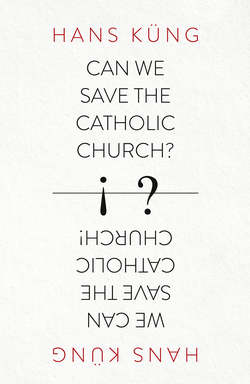Читать книгу Can We Save the Catholic Church? - Hans Kung - Страница 13
The Transition from a ‘Wintry’ Church to a Gravely Ill Church
ОглавлениеIn an interview given shortly before his death in 1984 and later published in Faith in a Wintry Season: Conversations and Interviews with Karl Rahner (1990), Karl Rahner, the great Jesuit theologian of the Council, described the desolate state the Church had fallen into as existing ‘in a wintry season’; this striking image soon made the rounds as a perfect description of the Church’s plight. Already in 1970, only a few years after the Council, Rahner used the opportunity afforded by his nomination as the first recipient of the Romano Guardini Prize to lash out openly against those responsible for this situation. At the award ceremony attended by Germany’s leading bishops, Rahner pilloried the ‘institutionalized mentality’ of the episcopate, describing it as ‘feudal, rude and paternalistic’. Behind this bitter outburst lay Rahner’s deep personal disappointment over the German episcopate’s cold-shouldered reaction to the cautiously formulated, confidential memorandum on clerical celibacy that he had drafted some months previously and sent to the German bishops with the signatures of eight other prominent German theologians. Not only did the bishops fail to respond to the theologian’s appeal to rethink the matter and take appropriate action; with two exceptions, they failed even to acknowledge receipt of the document.
Despite Rahner’s bitter words at the award ceremony, Cardinals Julius Döpfner and Hermann Volk and the other attending bishops showed not the slightest indication of a willingness to reconsider the prevailing position or to express even regret; instead they reacted with incomprehension, indignation and anger. From that time on, Karl Rahner became persona non grata, even among more progressive churchmen. Even Rahner’s own former assistant Karl Lehmann, who as professor in Mainz had personally subscribed to the memorandum and who would later become the Cardinal-Bishop of Mainz, did not support the increasingly critical course of his old friend. Commenting on Lehmann’s decision, Daniel Decker, his authorized biographer, wrote: ‘on that day, it became clear that Lehmann’s path within the Church could not be that of his theological mentor K. Rahner’.
Although in 1968, in the wake of Paul VI’s encyclical squashing further discussion of the celibacy issue, Rahner, on the orders of Cardinal Döpfner, had dutifully supported the official position with his own widely publicized Open Letter to the Clergy and although he had painstakingly formulated his confidential memorandum two years later in a moderate, submissive tone, he was denounced in conservative Catholic circles for using provocative formulations and embarrassing exposures to foment scandals, making use of popular media in order to publicly orchestrate conflict and controversy. Since then, compulsory celibacy – despite the dwindling numbers of priests and the emergency situation of many parishes – had been a taboo topic for the German Bishops’ Conference until 2010, when suddenly the breaking news of numerous hushed-up cases of clerical sexual abuse brought it to the fore. In other countries, it was the same story; the bishops, intimidated by Rome or prevented by their own dogmatic views, did their best to sit out the ongoing debates and ignore the increasingly vociferous demands for reform until they were pushed to take up the matter by public scandal and indignation.
Karl Rahner died in 1984 in wintry resignation, without having seen any harbingers of a new spring under a new pope. What would he say about the situation of his Church thirty years later? After three disappointing decades of Roman restoration under the pontificates of Wojtyla and Ratzinger, I am sure that he would agree that the advent of spring after such an icy winter will only be possible when we frankly admit that the Church is now seriously ill. It is not simply a matter of the individual, ‘ecclesiogenic neuroses created by the Church’, which the eminent Catholic psychotherapist Albert Görres had long ago diagnosed in the Church; the illness under which the Roman Catholic Church has long been suffering goes far beyond that: it consists in pathological, morbid structures within the Church itself. Not surprisingly, many now ask themselves: is the Church not critically, even terminally, ill?
My assessment of the prevailing condition of the Church has been confirmed by the analysis undertaken by Thomas von Mitschke-Collande, and underpinned by the results of numerous surveys. Mitschke-Collande, director emeritus of McKinsey/Germany and himself a committed Catholic, published a book in September 2010 entitled Kirche – was nun? Die Identitätskrise der katholischen Kirche in Deutschland (‘What’s Next for the Church? The Identity Crisis of the Catholic Church in Germany’). According to him, the problem involves five interlinked crises mutually reinforcing each other:
• a crisis of faith;
• a crisis of confidence;
• a crisis of authority;
• a crisis of leadership; and
• a crisis of dissemination.
Many people experience doubts about their belief in God for a variety of reasons, but when they find themselves in this situation they have little confidence in the ability of the Church and its representatives to help them. And that is understandable, because the authority of the Church itself is at an all-time low; the Church is suffering from a deep crisis of leadership and is virtually incapable of giving convincing witness to its official beliefs or explaining them in a way that can be understood.
Many recent events have combined to worsen the health of the Catholic Church. These events acted upon the Church like a case of chills, sending shivers down its body which – to continue with this analogy – served as warnings of repeated attacks of fever.
